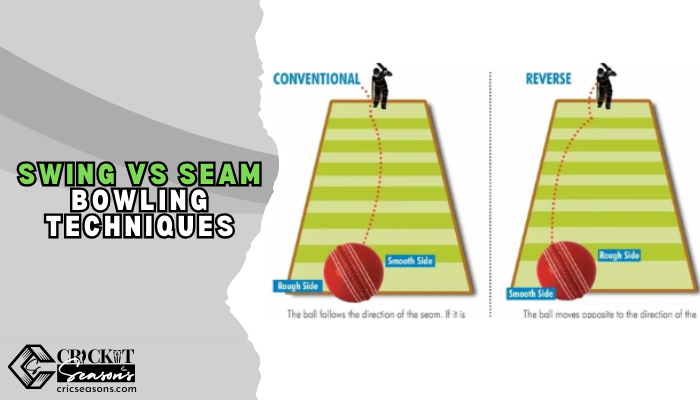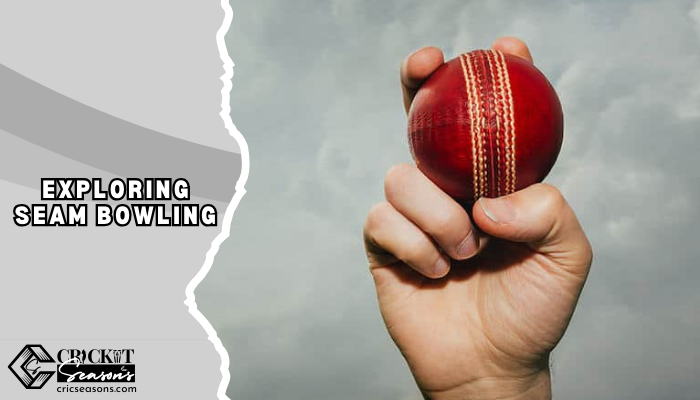Fast bowling in cricket is an art that separates the greats from the rest. Two of the most crucial techniques in this discipline are swing and seam bowling. Understanding the difference between these methods isn’t just for bowlers it’s essential for coaches, analysts, and fans too.
Each technique presents unique challenges to batters, making the game more exciting and unpredictable. So, which one truly holds the upper hand? Let’s break it down Swing vs Seam Bowling Techniques: How Can We Master in Both?
Contents
Understanding Swing Bowling
Swing bowling is a technique where the ball moves sideways through the air before reaching the batter. This movement is crucial for creating opportunities to dismiss the batter, often leading to edges that are caught by the wicketkeeper or slips. The success of swing bowling depends heavily on factors like the condition of the ball, the bowler’s grip, and the atmospheric conditions. For instance, humid or overcast weather tends to enhance swing, making it more difficult for the batter to predict the ball’s trajectory.
There are three main types of swing: inswing, outswing, and reverse swing. In an inswing, the ball moves toward the batter, making it harder to play shots on the offside. For an outswing, the ball moves away from the batter, often tempting them to play a shot and resulting in a possible edge. Reverse swing is more complex and occurs when the ball is older, with one side rough and the other shiny. This causes the ball to swing in the opposite direction of what the batter might expect, especially at high speeds.
Swing bowling requires precise seam positioning and a clean wrist action to control the ball’s movement in the air. It’s a skill that can make or break a game, depending on the conditions and the bowler’s ability to exploit them.
Exploring Seam Bowling
Seam bowling is a technique where the ball’s movement is influenced by how it interacts with the pitch after bouncing. Unlike swing bowling, which relies on air movement, seam bowling focuses on the ball’s seam position and how it hits the pitch. When the seam is upright, the ball is more likely to deviate off its course, making it difficult for the batter to judge.
The seam position is critical in this technique. Bowlers aim to keep the seam upright, so it hits the pitch at the right angle, causing the ball to move unpredictably. Pitch conditions play a significant role in seam bowling. For example, pitches with cracks, grass, or moisture will enhance seam movement, making the ball change direction sharply upon bouncing.
Another key aspect of seam bowling is its unpredictability. While swing bowling has a more predictable trajectory through the air, seam bowling can cause random deviations after the ball pitches, depending on how it strikes the seam. This unpredictability forces batters to remain cautious, as even a slight deviation can lead to an edge or a mistimed shot.
Comparative Analysis: Swing vs Seam Bowling
Swing and seam bowling are both vital techniques in a bowler’s arsenal, but they differ significantly in execution and effectiveness. Swing bowling primarily involves the movement of the ball through the air, influenced by the bowler’s grip, seam position, and weather conditions. This technique is highly effective in overcast or humid environments where the ball can move sharply in the air, making it challenging for batters to judge its path.
In contrast, seam bowling depends on how the ball interacts with the pitch after it bounces. The seam’s position at the point of delivery determines whether the ball will deviate when it hits the ground. Seam bowling is more reliant on the pitch condition—grassy or cracked pitches tend to favor seamers. Unlike swing, which is more predictable, seam can be chaotic, with the ball moving in unexpected ways, adding an element of surprise.
Situational effectiveness is another critical factor. Swing bowling is generally more effective with a newer ball, particularly in the early overs when the seam is prominent, and the ball’s surface is less scuffed. Seam bowling, however, can be effective throughout the innings, especially on pitches that offer assistance to the bowlers. This technique is often employed when the ball has lost its shine, and swing becomes less effective.
Iconic Bowlers in Swing Bowling
Iconic bowlers like Glenn McGrath and Wasim Akram have mastered these techniques, using them to outwit batters in different conditions. McGrath’s ability to consistently hit the seam made him a nightmare for batters, while Akram’s control over swing, particularly reverse swing, made him one of the most feared bowlers in cricket history.
F.A.Q.
1. What conditions favor swing bowling?
Ans: Swing bowling thrives in humid or overcast conditions. These atmospheric conditions create a heavier air density, which aids in the movement of the ball through the air. Early in the innings, when the ball is newer and the seam is more pronounced, swing bowlers can exploit these conditions to generate significant movement.
2. How can a bowler master both swing and seam techniques?
Ans: Mastering both swing and seam requires a combination of practice, understanding of conditions, and technical precision. For swing bowling, bowlers need to focus on their grip, wrist position, and the seam’s orientation. They should practice delivering the ball with consistent seam positioning to achieve the desired swing.
For seam bowling, the emphasis is on controlling the seam’s upright position and landing the ball on the seam regularly. Understanding pitch conditions and adjusting the length and line accordingly are also critical for maximizing seam movement.
3. Why is reverse swing considered a high-risk, high-reward strategy?
Ans: Reverse swing is effective when the ball is older and the surface is uneven, with one side polished and the other rough. It requires high speed and precise seam positioning, making it difficult to execute consistently.
However, when done correctly, it can be devastating, as the ball moves in the opposite direction to conventional swing, often catching batters off guard. The challenge lies in maintaining the ball’s condition and delivering it with the perfect balance of speed and seam alignment.
4. What makes seam bowling more unpredictable than swing?
Ans: Seam bowling’s unpredictability stems from the ball’s interaction with the pitch after it bounces. When the seam hits the pitch at an angle, the ball can move in any direction, depending on the pitch’s condition. This randomness makes it harder for batters to anticipate the ball’s path, especially on pitches with cracks or uneven surfaces.
In contrast, swing bowling, while challenging, follows a more predictable pattern through the air, allowing batters to make adjustments more easily.
Wrapping Up
Swing and seam bowling are two techniques that bring unique challenges to the game of cricket. Swing bowling is all about controlling the ball’s movement through the air, making it essential in conditions that favor such deviation, like humidity or cloud cover. On the other hand, seam bowling relies on the ball’s interaction with the pitch, where even slight deviations can confuse and outmaneuver the batter. While swing might be more predictable, seam bowling introduces an element of unpredictability that can turn the tide of a match in the bowler’s favor.
Both techniques have their place in cricket, and mastering them can set apart the good bowlers from the great ones. Whether it’s the early movement in swing bowling that tests a batter’s skill or the late deviation in seam bowling that catches them off guard, each technique requires a deep understanding of conditions, ball control, and strategic thinking.


